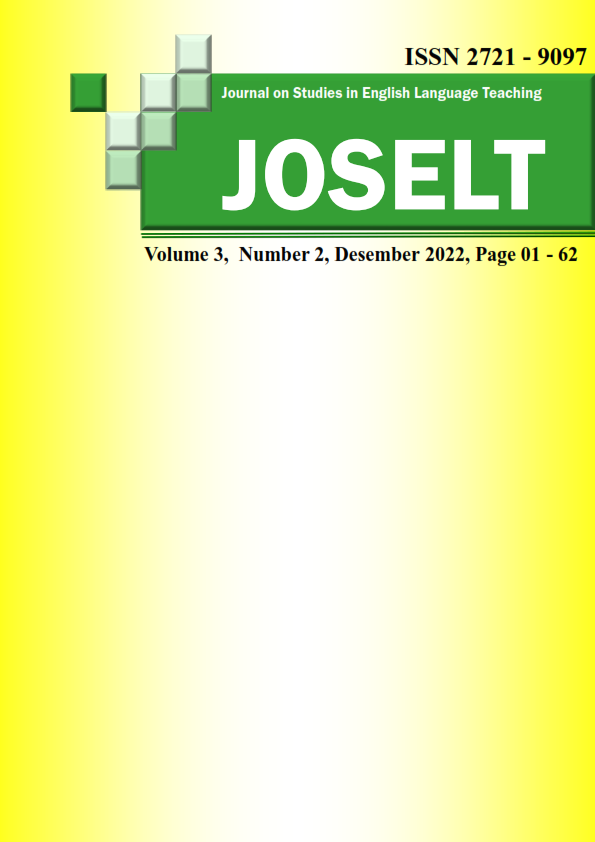BRAINSTORMING, ACTIVATING, REINFORCING, APPLYING (BARA) AS A LEARNING STRATEGY IN LISTENING COMPREHENSION CLASSROOM
Keywords:
classroom, listening, comprehension, strategy, learningAbstract
Listening comprehension is an important language skill that needs to be developed continuously and intensively to enhance the student's language competence. This study used a classroom action research design conducted in two cycles of learning activities to improve students' listening comprehension through the BARA learning strategy. Indonesian educators developed the BARA learning strategy consisting of four learning stages: brainstorming, activating, reinforcing, and applying. This trial of the BARA strategy in an EFL classroom established the final construction of the BARA learning strategy. Data collection was done by administering a pretest, posttests and a questionnaire. The results showed that the student's listening comprehension improved significantly in the first and second learning cycles compared to the pretest result. Therefore, the BARA strategy is very effective in teaching listening comprehension. This study suggests that teachers should consider using the BARA learning strategy to improve students' language competence.
References
Ahmadi, Seyedeh, M. (2016). The Importance of Listening Comprehension in Language Learning. International Journal of Research in English Education, 1(1), 7–10.
Astawa, I. N., Mantra, I. B. N., & Widiastuti, I. A. M. S. (2017). Developing communicative English language tests for tourism vocational high school students. International Journal of Social Sciences and Humanities, 1(2), 58–64. https://doi.org/10.29332/ijssh.v1n2.43.
Astawa, I. N., Mantra, I. B. N., & Widiastuti, I. A. M. S. (2018). Communicative English Language Test : A Prospective Measuring Device For Tourism Practitioners ’ Employability. Proceeding The 9th International Conference of Rural Research and Planning Group (IC-RRPG), 9(July), 219–230.
Burns, A. (2010). Doing Action Research in English Language Teaching. New York: Routledge.
Constantine, P. (2007). Podcasts: another source for listening input. The Internet TESL Journal, 13(1), 143–156.
Ghaderpanahi, L. (2012). Using authentic aural materials to develop listening comprehension in the EFL classroom. English Language Teaching, 5(6), 146–153. https://doi.org/10.5539/elt.v5n6p146.
Handayani, N. D., Mantra, I. B. N., & Suwandi, I. N. (2019). Integrating collaborative learning in cyclic learning sessions to promote students’ reading comprehension and critical thinking. International Research Journal of Management, IT and Social Sciences, 6(5), 303–308. https://doi.org/10.21744/irjmis.v6n5.777.
Khuziakhmetov, A. N., & Porchesku, G. V. (2016). Teaching listening comprehension: Bottom-up approach. International Journal of Environmental and Science Education, 11(8), 1989–2001. https://doi.org/10.12973/ijese.2016.572a.
Mantra, I.B.N, Kumara, D. A. . (2018). Folktales As Meaningful Cultural and Linguistic Resources To Improve Students’ Reading Skills. Lingua Scientia, 25(2), 83. https://doi.org/10.23887/ls.v25i2.18827.
Mantra, I. B. N., Handayani, N. D., & Suwandi, I. N. (2019). Quantum Learning As A Natural Way To Improve Students’language Competence. International Journal of Applied Science and Sustainable Development (IJASSD), 1(2).
Mantra, I. B. N., Widiastuti, I. A. M. S., Handayani, N. D., & Pramawati, A. A. I. Y. (2020). English Language Urgency For Tourism And Hospitality Employees To Boost Global Economy. PalArch’s Journal of Archaeology of Egypt/Egyptology, 17(7), 5458–5469.
Mantra, I. B. N., Handayani, N. D., & Kumara, D. G. G. (2022). Brainstorming , Activating , Reinforcing And Applying (BARA) To Upraise Students ’ Reading Comprehension. International Journal of Linguistics and Discourse Analytics 4(1), 41–48.
Mantra, I. B. N., Widiastuti, I. A. M. S., Suwandi, I. N., & Laksmi, A. A. R. (2020). Procedural Demonstration as a Practical Learning Contrivance to Ameliorate Students’ Writing Skill. International Journal of Linguistics and Discourse Analytics (IJOLIDA), 2(1), 71–78.
Rastikawati, E. F. (2021). Effects of technology enhanced task-based language teaching on learners’ listening comprehension and speaking performance. International Journal of Instruction, 14(3), 717–736. https://doi.org/10.29333/iji.2021.14342a.
Pangaribuan, T., Sinaga, A., & Sipayung, K. T. (2017). The Effectiveness of Multimedia Application on Students Listening Comprehension. English Language Teaching, 10(12), 212. https://doi.org/10.5539/elt.v10n12p212.
Radhika, V. (2017). Importance of Communication in Language Learning. Ijellah, V(II), 127–131.
Vasiljevic, Z. (2010). Dictogloss as an Interactive Method of Teaching Listening Comprehension to L2 Learners. English Language Teaching, 3(1), 41–52. https://doi.org/10.5539/elt.v3n1p41.
Wallace, T., Stariba, W. E., & Walberg, H. J. (2004). Teaching Speaking, Listening and Writing. International Academy of Education, May, 13.
Zhang, Y. (2012). The impact of listening strategy on listening comprehension. Theory and Practice in Language Studies, 2(3), 625–629. https://doi.org/10.4304/tpls.2.3.625-629.

